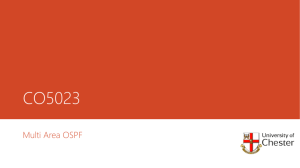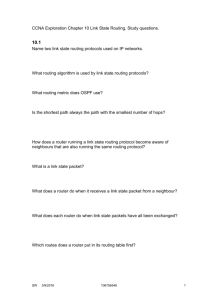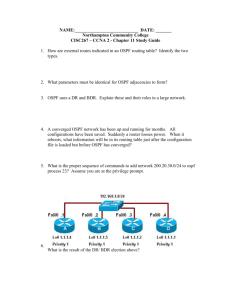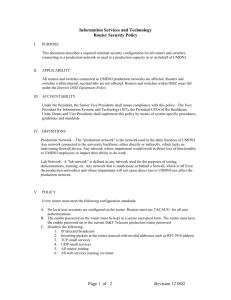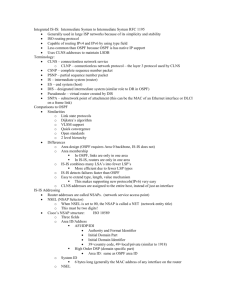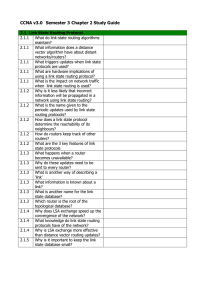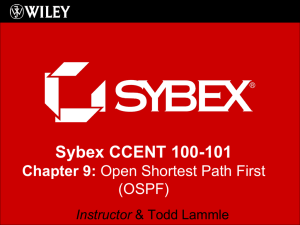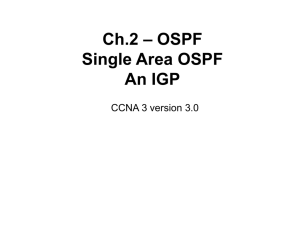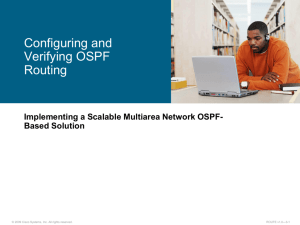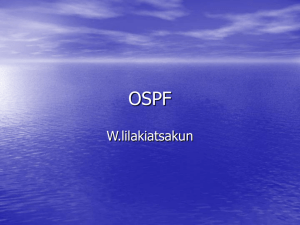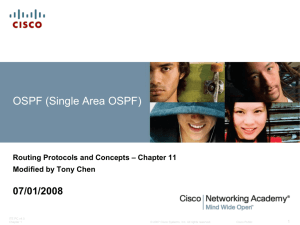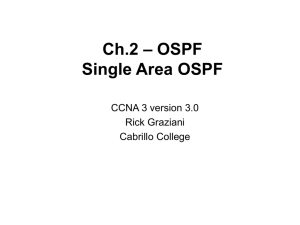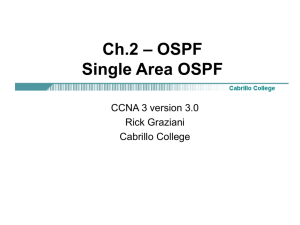CCNP Network Route -OSPF Part
advertisement
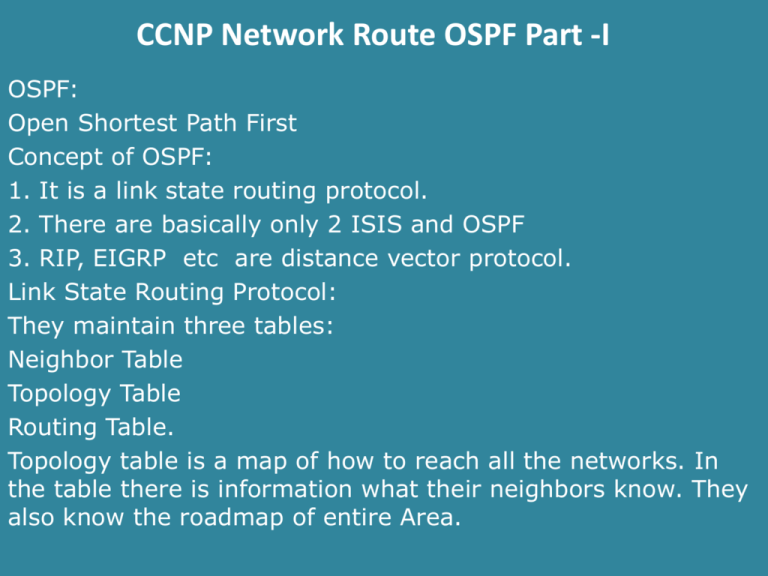
CCNP Network Route OSPF Part -I OSPF: Open Shortest Path First Concept of OSPF: 1. It is a link state routing protocol. 2. There are basically only 2 ISIS and OSPF 3. RIP, EIGRP etc are distance vector protocol. Link State Routing Protocol: They maintain three tables: Neighbor Table Topology Table Routing Table. Topology table is a map of how to reach all the networks. In the table there is information what their neighbors know. They also know the roadmap of entire Area. CCNP Network Route OSPF Part -I Link state protocols are processor intense. Link state routing protocol use Dijkstras shortest path first (SPF) Algorithm. They only send update when there is change to network. They also send LS (Link State Refresh) after long intervals. It’s actually their routing table. In OSPF it’s about once every 30 mins. OSPF divides the network into multiple areas. Every single area consist of group of Routers. All areas must connect to area 0. Area 0 is the first area and backbone area. All routers in an area have same topology table. CCNP Network Route OSPF Part -I ABR or Area Border Router: Every router which is a sitting between two routers is called ABR or Area Border Router. It’s one interface or leg is in Area 0 and other in another area. ASBR: Autonomous system boundary router is a Router which is connected outside our network such as Internet. Note: In OSPF only ABR & ASBR can do summarization. Bigger the area more growth of the map which results in intense calculations every single time a change has been made because all routers must know about it. OSPF has a hierarchical design. CCNP Network Route OSPF Part -I OSPF Neighbor Formation: In OSPF Neighbors are only formed between the routers in the same area. First of all Router will determine its own Router ID”. Router ID is the Router name. Note: Highest Active Interface IP address will become the Router ID. Among 10.1.1.1, 172.30.1.1 and 192.168.1.1, 192.168.1.1 will become the Router ID. Loopback interface beats the physical Interface. So this IP becomes its identifier among other routers. Loopback address how small will win the election. OSPF router ID only changes if we reboot the router or OSPF process is restarted. CCNP Network Route OSPF Part -I We should hardcode the Router ID in-order to prevent disasters. Router adds it’s interfaces to the link state database. The router then sends a hello messages on chosen interface(s) [At the moment it’s in Down state] By default Hellos are send every 10 seconds on Broadcast and p-2-p network 30 secs on NBMA Networks such as ATMs Note: 1. Hello and dead timers should be same on the routers in order to become neighbors. 2. Neighbors should have same subnet mask, else neighbors won’t form 3. They have to be in the same area. 4. OSPF is password protected and auth is required. CCNP Network Route OSPF Part -I Various States: Init State: When Router Receive Hello it check every required options to become neighbor if it fails it goes to down state. Basically it checks: 1. Hello / Dead Intervals 2. Netmask 3. Area ID 4. Authentication Password 2. Router Sends Reply to Hello : The Router checks if it’s listed in the router’s hello packet. IF yes then reset dead Timer IF No , it adds as a new Neighbor. CCNP Network Route OSPF Part -I IF Router R1 and R2 are new neighbors. They Exchange start State which is known as Exstart State. It means who sends the information first. Masters sends first and Slave sends second. Master is determined by router’s priority. Default priority is 1, The higher router id wins. Master sends a database description packet. Slaves sends its database descriptions packets. Databases are acknowledged and reviewed. Basically in Master / Slave DB exchange, Routers exchanges Networks like which networks it knows about and which it don’t. CCNP Network Route OSPF Part -I 3 Loading State: They load information into memory. Process takes place in which following happens: a. Slave requests details (such as Link State Request) b. Master Sends update ( Link state update) c. Master Requests Details ( LSR) d. Slave Sends Update ( LSU) Once all steps are completed. Neighbors are formed. Checks neighbors by following command: # show ospf neighbors.
